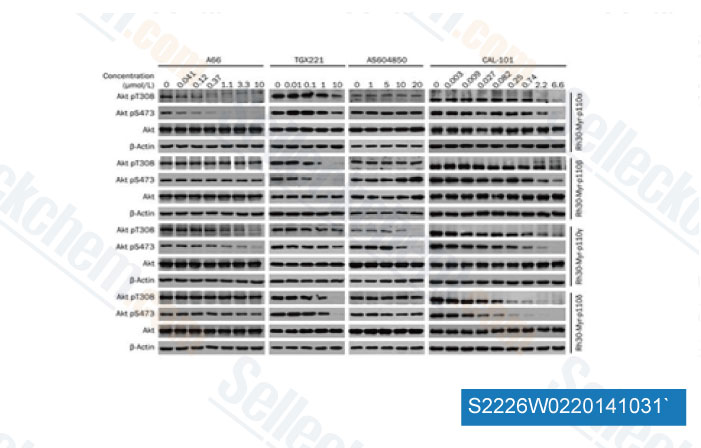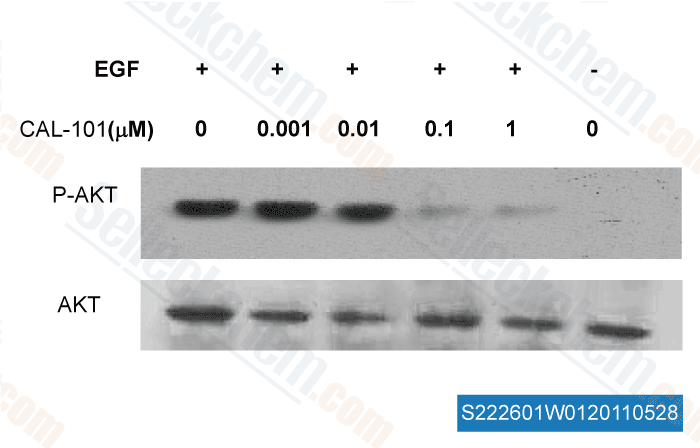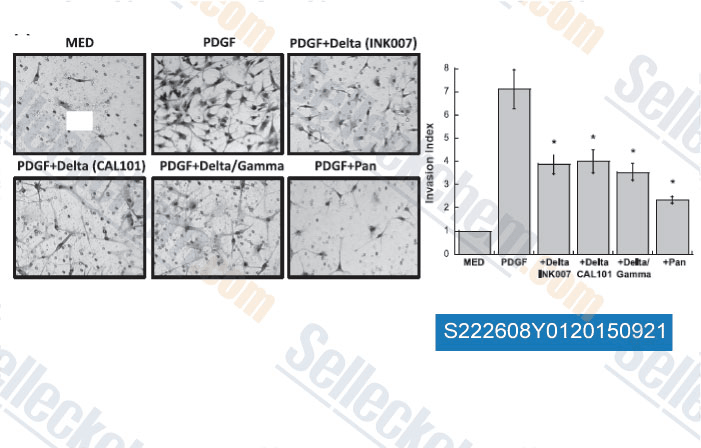|
Toll Free: (877) 796-6397 -- USA and Canada only -- |
Fax: +1-832-582-8590 Orders: +1-832-582-8158 |
Tech Support: +1-832-582-8158 Ext:3 Please provide your Order Number in the email. |
Technical Data
| Formula | C22H18FN7O |
|||
| Molecular Weight | 415.42 | CAS No. | 870281-82-6 | |
| Solubility (25°C)* | In vitro | DMSO | 100 mg/mL (240.72 mM) | |
| Ethanol | 34 mg/mL (81.84 mM) | |||
| Water | Insoluble | |||
|
* <1 mg/ml means slightly soluble or insoluble. * Please note that Selleck tests the solubility of all compounds in-house, and the actual solubility may differ slightly from published values. This is normal and is due to slight batch-to-batch variations. * Room temperature shipping (Stability testing shows this product can be shipped without any cooling measures.) |
||||
Preparing Stock Solutions
Biological Activity
| Description | Idelalisib (CAL-101) is a selective p110δ inhibitor with IC50 of 2.5 nM in cell-free assays; shown to have 40- to 300-fold greater selectivity for p110δ than p110α/β/γ, and 400- to 4000-fold more selectivity to p110δ than C2β, hVPS34, DNA-PK and mTOR. Idelalisib also stimulates autophagy. | ||||
|---|---|---|---|---|---|
| Targets |
|
||||
| In vitro | CAL-101 is not sensitive to other PI3K class I subunits including p110α, p110β, and p110γ. CAL-101 specifically blocks FcϵR1 p110δ-mediated CD63 expression with an EC50 of 8 nM in primary basophil. CAL-101 exhibits greater activity in B-cell acute lymphoblastic leukemia (B-ALL) and chronic lymphocytic leukemia (CLL) cells compared with acute myeloid leukemia (AML) and myeloproliferative neoplasm (MPN) cells. CAL-101 produces the reduction in pAktS473, pAktT308, and the downstream target S6 in SU-DHL-5, KARPAS-422 and CCRF-SB cells with EC50 of 0.1 to 1.0 μM. [1] CAL-101 induces selective cytotoxicity in CLL cells independent of IgVH mutational status or interphase cytogenetics, primarily through a caspase-dependent mechanism. CAL-101 induces cytotoxicity preferentially to CLL cells compared with normal B cells, without producing cytotoxicity in other hematopoietic cells, compared to LY294002. CAL-101 lacks direct cytotoxic potential to T cells and nature killer (NK) cells. CAL-101 can inhibit production of inflammatory cytokines, such as IL-6, IL-10, TNF-α, and IFN-γ, and activation-induced cytokines, such as CD40L. CAL-101 also antagonizes CD40L-mediated CLL cell survival. [2] CAL-101 induces an accumulation of cells in G1 and a decrease in the S-phase population in L1236 and L591 cells, which indicates CAL-101 as a novel strategy for the treatment of hodgkin lymphoma (HL). [3] |
Protocol (from reference)
| Kinase Assay: |
|
|---|---|
| Cell Assay: |
|
References
Customer Product Validation

-
Data from [Data independently produced by Cell Death Differ, 2014, 21(10), 1535-45]

-
Data from [Data independently produced by Acta Pharmacol Sin, 2013, 34(9),1201-7]

-
, , Dr. Zhang of Tianjin Medical University

-
Data from [Data independently produced by , , J Immunol, 2014, 192(5): 2063-70 ]
Selleck's Idelalisib (CAL-101) has been cited by 295 publications
| Mitigating T-Cell Mitochondrial Dysfunction in CLL to Augment CAR T-Cell Therapy: Evaluation in an Immunocompetent Model [ Blood Adv, 2025, bloodadvances.2024014822] | PubMed: 39938006 |
| FoxO1/Rictor axis induces a nongenetic adaptation to ibrutinib via Akt activation in chronic lymphocytic leukemia [ J Clin Invest, 2024, 134(23)e173770] | PubMed: 39436708 |
| Complement factor H is an ICOS ligand modulating Tregs in the glioma microenvironment [ Cancer Immunol Res, 2024, 10.1158/2326-6066.CIR-23-1092] | PubMed: 39378431 |
| Longitudinal phosphoproteomics reveals the PI3K-PAK1 axis as a potential target for recurrent colorectal liver metastases [ Cell Rep, 2024, 43(12):115061] | PubMed: 39689713 |
| PI3K-dependent reprogramming of hexokinase isoforms controls glucose metabolism and functional responses of B lymphocytes [ iScience, 2024, 27(10):110939] | PubMed: 39635128 |
| The highly selective and oral phosphoinositide 3-kinase delta (PI3K-δ) inhibitor roginolisib induces apoptosis in mesothelioma cells and increases immune effector cell composition [ Transl Oncol, 2024, 43:101857] | PubMed: 38412661 |
| JAK3/STAT5 signaling-triggered upregulation of PIK3CD contributes to gastric carcinoma development [ J Cell Commun Signal, 2024, 18(1):e12017] | PubMed: 38545256 |
| Evolutionary states and trajectories characterized by distinct pathways stratify patients with ovarian high grade serous carcinoma [ Cancer Cell, 2023, 41(6):1103-1117.e12] | PubMed: 37207655 |
| PD-1 instructs a tumor-suppressive metabolic program that restricts glycolysis and restrains AP-1 activity in T cell lymphoma [ Nat Cancer, 2023, 4(10):1508-1525] | PubMed: 37723306 |
| Alcam-a and Pdgfr-α are essential for the development of sclerotome-derived stromal cells that support hematopoiesis [ Nat Commun, 2023, 14(1):1171] | PubMed: 36859431 |
RETURN POLICY
Selleck Chemical’s Unconditional Return Policy ensures a smooth online shopping experience for our customers. If you are in any way unsatisfied with your purchase, you may return any item(s) within 7 days of receiving it. In the event of product quality issues, either protocol related or product related problems, you may return any item(s) within 365 days from the original purchase date. Please follow the instructions below when returning products.
SHIPPING AND STORAGE
Selleck products are transported at room temperature. If you receive the product at room temperature, please rest assured, the Selleck Quality Inspection Department has conducted experiments to verify that the normal temperature placement of one month will not affect the biological activity of powder products. After collecting, please store the product according to the requirements described in the datasheet. Most Selleck products are stable under the recommended conditions.
NOT FOR HUMAN, VETERINARY DIAGNOSTIC OR THERAPEUTIC USE.
